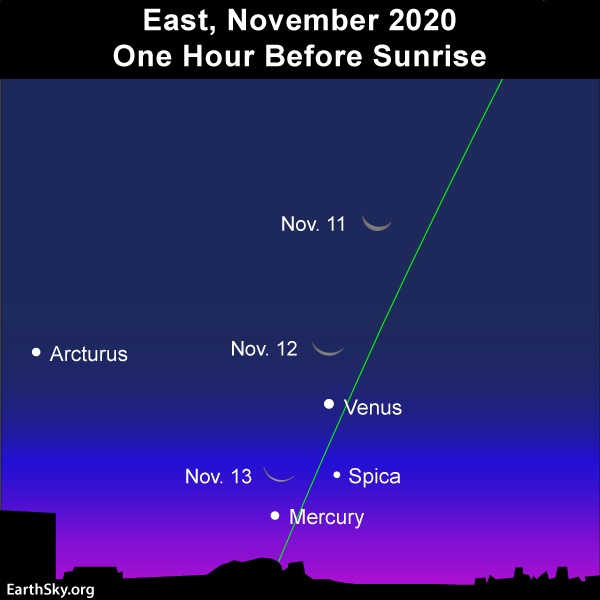From midnight to dawn this weekend – say, beginning on the mornings of November 14 or 15, 2020 – watch for meteors in the annual Leonid meteor shower. The new moon on November 15 guarantees dark skies in rural locations on the shower’s peak mornings. The meteors are expected to fall most abundantly in the dark hours before dawn on Tuesday, November 17, but we’re already hearing from people who are seeing Leonid meteors.
At the shower’s peak, you might see as many as 10 to 15 meteors per hour.
The usual rules for meteor-watching apply: go to a dark country location in the hours before sunrise. Bring along a lawn chair or blanket for stretching out and gazing upward over a period of at least an hour. Will you see any meteors this weekend? Maybe!

The Leonids are famous for storming at various times in history. The first great meteor storm of modern times was nearly 200 years ago; it was the Leonid shower of November 1833. That famous shower had a major effect on the development of the scientific study of meteors. It’s one reason the Leonids are so famous. Prior to the Leonid storm of 1833, meteors were thought to be atmospheric phenomena, like rain or snow. But scientists were curious. Why was the 1833 shower so strong? In 1865, astronomers discovered a comet, which was named Comet Tempel-Tuttle for its discoverers. The comet’s orbit around the sun was found to be about 33 years. Some predicted that there would be another Leonid meteor storm in November 1866 – and so there was!
Thus the Leonid meteor storm of 1833 helped prove that meteors in annual shower originate in comets.
Now we know that Earth crosses the orbital path of Comet Tempel-Tuttle every year. Debris from this comet burns up in the Earth’s upper atmosphere to create the annual Leonid shower. It’s only when the comet is near that we see a Leonid storm.
The illustration below depicts the 1833 Leonid meteor shower, said to have produced from 100,000 to 200,000 meteors per hour! This old woodcut, published in 1888, shows what the Leonid shower might look like in a year that this shower erupts into storm, bombarding the sky with hundreds of thousands of meteors.

The last major Leonid meteor storm was in 1966, when many in North America saw 100,000 shooting stars per hour. Because meteors in annual showers – like the Leonids – all stem from a single radiant point on our sky, some observers of the shower in 1966 commented that they felt they “almost needed to grip the ground,” so strong was the sensation of Earth’s movement through space.
Since then, the Leonids have put on some stunning displays, but nothing to match the 1966 shower.
Will there be a Leonid storm in 2020? That’s one prediction we can make with a fair amount of certainty, and the answer is no. No storm or heightened meteor activity is anticipated for the Leonid meteor shower in 2020. That’s because the parent comet of the Leonid shower is not nearby.
The comet takes just over 33 years to orbit the sun. Its last perihelion (closest point to the sun) was February 28, 1998. Its next expected perihelion is May 20, 2031. So we’ve got a while to wait for the next Leonid storm!
When they’re not storming, the Leonids are a modest, though reliable, shower. In a dark, moonless sky, you might see up to 10 to 15 meteors per hour. The absence of moonlight will undoubtedly enhance the view of this shower in 2020.
Even watching just one meteor flying across the sky can count as a big thrill. A good percentage of these swift-moving meteor leave persistent trains – glowing trails of ionized gas that last for a few moments are the meteor has gone!
On a dark night, we typically see the most Leonid meteors streaking the sky in the hour before before dawn because that’s when the constellation Leo the Lion – the radiant point of the shower – is found highest in the sky. In 2020, look for the dazzling planet Venus in the predawn/dawn sky. Then, as the predawn darkness gives way to morning twilight, seek for Mercury, the innermost planet, below Venus and near the horizon. Click here for an almanac telling you when these planets will rise into your sky.
Some of you might have caught the waning crescent moon with Venus and Mercury the last several mornings. (See chart below.) But, starting on or near November 14, 2020, the old moon will probably be too close to the the glare of sunrise to be seen. The upcoming new moon on November 15 means dark skies for the Leonid shower at its peak.

Many ask about the radiant points of meteor showers. Please know that you don’t have to locate the radiant point to watch the Leonid shower, for these meteors fly all through the starry heavens. But it’s fun to know where the radiant lies in the sky. When tracing the paths of the Leonid meteors backward, they appear to radiate from the constellation Leo the Lion. Therefore, the meteors in this annual shower are named for this constellation. As seen from mid-northern latitudes, Leo rises over the eastern horizon around 1 a.m. After rising, Leo then climbs upward and westward, soaring to its highest point in the southern sky around 6:30 a.m. local time.
Bottom line: On the morning of November 17, 2020 – and the mornings leading up to it – find a dark sky away from pesky artificial lights, enjoy the comfort of a reclining lawn chair or sleeping bag, and watch for the swift-moving and often bright Leonid meteors. The new moon on November 15 guarantees a dark sky.
How high up are meteors when they begin to glow?
Do you love stargazing? Order your EarthSky Planisphere today











